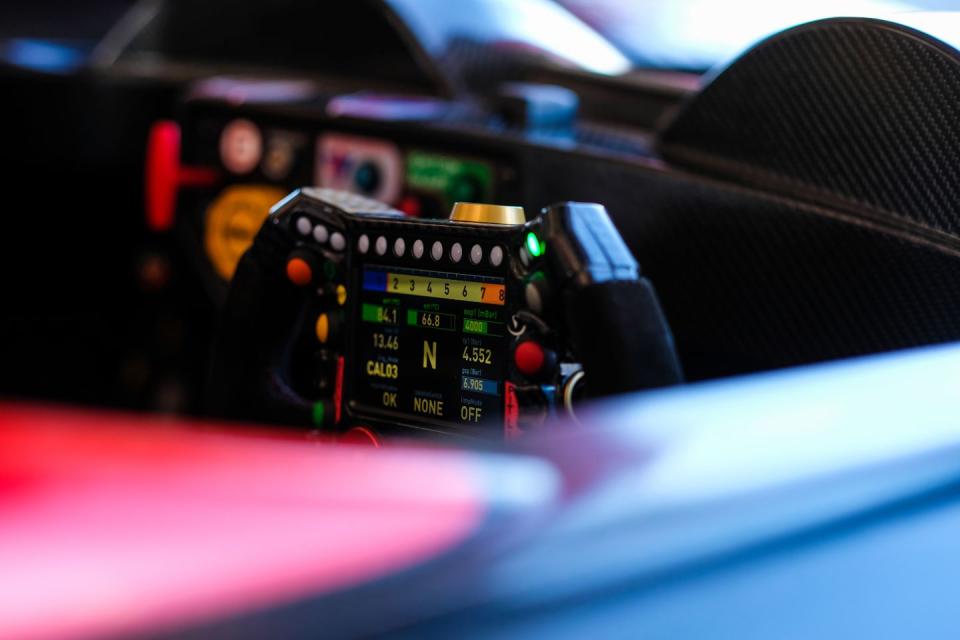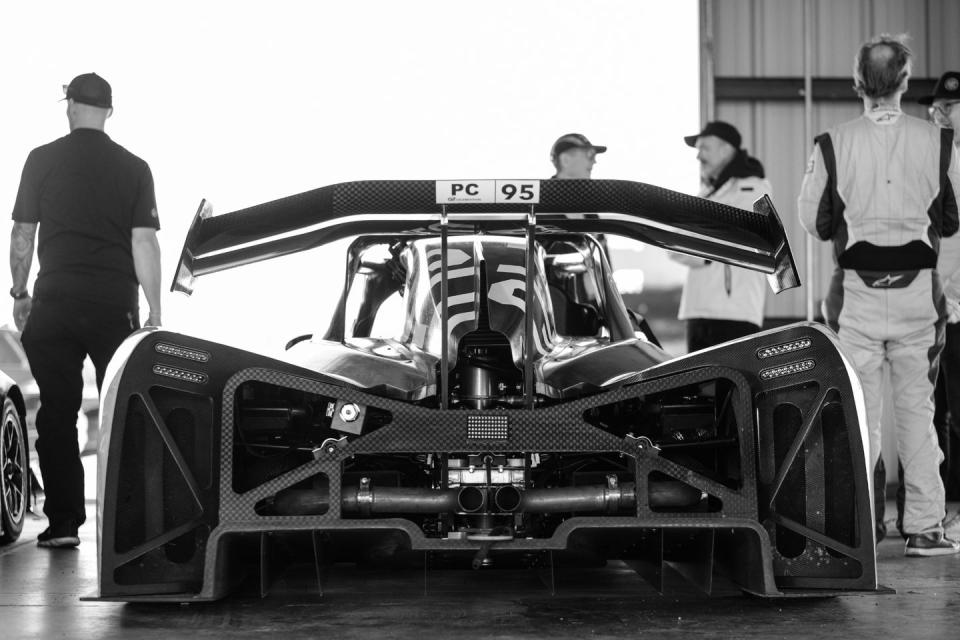On Track, Revolution A-One Is a $193,000 Endorphin Dispenser

The Revolution A-One is the latest giant slayer from esteemed British engineer Phil Abbott, with final assembly in Peterborough, UK.
The car gets a German-built carbon-fiber monocoque, born of an efficient resin-transfer molding process (a la McLaren), that earns full FIA safety approval.
“As long as your inputs are correct, it won’t let you down,” longtime racer Phil Kavanagh says after driving the A-One.
So much ink is spilled, media laps duly recorded, and arguments waged, over the track potential of cars whose actual buyers rarely turn a single lap.
Of late, I’ve seen more Radicals at a single track day than the number of Ferraris or Lamborghinis I’ve spotted over a decade. That should tell you something: Mazda Miatas aside, well-funded drivers and race outfits are keenly interested in genuine track cars, versus even supercars whose street-going compromises are quickly exposed on a circuit.
Those lessons are driven home when I mash the sturdy Tilton pedals of the Revolution A-One, and experience ground-sucking braking and cornering not far removed from a LeMans prototype.
The A-One is rock-your-world quick, as you’d expect from a carbon-fiber waterbug that combines 500 supercharged horsepower with a dry weight of 1870 pounds—barely half the weight of a new Chevy Corvette Z06.
But what really brightens this track day is how un-intimidating the Revolution is to drive: Fast, minus the freak-out of some pro racecars whose every inscrutable switch or fast-twitch reaction tells you you’re better off in a Porsche Cayman.
This $193,000 endorphin dispenser is the latest giant slayer from esteemed British engineer Phil Abbott, with final assembly in Peterborough, UK. Abbott is the now-departed co-founder of Radical, the vaguely road-legal sports prototype that set a Nurburgring record in 2005.
Versus the Radical’s now-antiquated tube frame, the Revolution gets a German-built carbon-fiber monocoque, born of an efficient resin-transfer molding process (a la McLaren), that earns full FIA safety approval.
Peter Watt, who served as composites chief of the BAR F1 team and worked on Bentley’s LeMans program, led structural and CAD design. Simon Cox, the former Infiniti and General Motors designer, styled the aggro body.
Abbott and son James Abbott, the lead development driver, transformed a humble 3.7-liter Ford Cyclone V-6 crate engine into a 427-hp banshee. That includes new pistons, cams, bespoke six-throttle induction, and dry-sump oiling that lowers the center of gravity. Acquiescing to North American tastes for ever-more power, the Abbotts strapped a centrifugal supercharger to the 500-hp version, which starts at $208,000.

A double-wishbone suspension with inboard dampers gets an adjustable third element for easy circuit tuning. Two carbon-fiber wings, coaxed into shape via extensive computational fluid dynamics design, help generate more than 1500 pounds of downforce at 110 mph. The new Porsche 911 GT3 RS I recently drove at Silverstone makes more downforce than any showroom car in history, but still a relatively slight 900 pounds at 124 mph.
The track-only A-One also aims for low running costs: It can run 93-octane pump gas and romp on track for about 6200 miles or 100 hours before any major servicing.
Suited, booted and Hans-deviced, my first stint at New Jersey Motorsports Park brings one first-gear stall, from a clutch pedal designed solely for leaving the pits. But soon enough, I’m shrieking around the Thunderbolt circuit, paying attention to downforce-aided, left-foot braking, and rolling momentum through corners, rather than worrying about how hard this car might bite.
The open-top sensations are incredible, though I rue my decision to forego ear protection: The raging V-6 turns my helmet into a boombox with its 108-decibel induction racket. The cut-down, F1-style steering wheel goes blessedly easy on confusing, intimidating switches. A six-speed 3MO sequential gearbox feels nearly as easy as paddling an Audi around town.
Nine-position traction control helps drivers build speed and confidence. It helps that you can see out of the thing, with a surprisingly elbow-roomy cockpit and upright driving position, versus the half-prone Pilates stretch of some racers. A pair of thin carbon-fiber seats allows an (ideally) well-compensated coach, in a car designed for either track days or amateur racers.
In support races for F1 and other series, at tracks including Monza and Portimao, top Revolution pilots are putting up lap times just 1 or 1.5 seconds behind full LMP3 cars—remarkable pace for such a user-friendly, relatively attainable car.
I’m barely scratching that surface, as a few scorching right-seat laps with James Abbott remind me. Pulling some data, Abbott shows me how I could be crushing the brake pedal much harder, so I go out and try it again. Man, what I’d give for a few days or weeks behind the Revolution’s wheel, aside from it spoiling me for any street car.
Versus the Italian-built Wolf track car that I drove on a New York circuit—or any Radical—the Revolution feels faster and stronger, a palpably next-generation advance. Kick the price to around $218,000, and owners get bonus wheels and other spares, lightweight bodywork, and uprated dampers. Most importantly, an elegant carbon-fiber cockpit halo fairing proved its worth when one airborne Revolution tried to give another driver a haircut at Monza. Both drivers walked away unscathed.
That combination of performance and self-preservation was enough for Steffen Rilli, a former Porsche GT3 Cup team manager and chief mechanic for Aston Martin’s #7 DBR9 racer.

Now the owner of Rilli Racing in Ontario, the German native has led his team to four Radical Canada Cups. He was there at New Jersey Motorsports Park to take possession of the first of three new Revolutions as he segues his drivers into this wicked new machine.
“The Radical is a great car, but it hasn’t advanced,” Rilli says. “My core value is safety, so I want the most modern safety and tech we can run. I rarely get excited about race cars anymore, but just the pure sound of it…I was getting goosebumps.”
Phil Kavanagh, a longtime racer, Abbott compatriot, and co-founder of the Classic Car Club in London and Manhattan, is hooked as well.
“As long as your inputs are correct, it won’t let you down,” Kavanagh says, echoing Rilli’s views for ambitious amateurs who aren’t in Lewis Hamilton’s league or doing this for a paycheck. “We all want to have fun, but we have to go to work on Monday, and get home safe.”
Is the Revolution A-One on your wish list of track day fun runners? Please comment below.

 Yahoo Autos
Yahoo Autos 